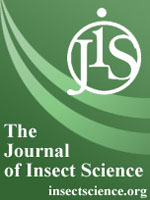The wheat stem sawfly, Cephus cinctus Norton (Hymenoptera: Cephidae), is a key pest of wheat in the northern Great Plains of North America. Host plant resistance in the form of solid-stemmed wheat cultivars is the main control strategy for C. cinctus. This study investigated the effect of novel and traditional solid wheat hosts on the overwintering mortality and cold-hardiness of C. cinctus. Field conditions from 2003–2005 showed that overwintering mortality in various wheat cultivars averaged 8% and was not related to the type of wheat cultivar. Similarly, supercooling points (-22° C) were not influenced by wheat host type. C. cintus are cold-hardy; up to 80% survive 10 days at -20° C and 10% survive 40 days. Its overwintering microhabitat near the crown area of the plant is well insulated for temperatures above -10° C and remains ∼ 20° C above ambient minima. These data suggest that winter mortality is a minor factor in the population dynamics of wheat stem sawfly, and despite clear detrimental effects on larval weight and adult fitness, solid-stemmed cultivars do not reduce the ability of larvae to survive winters.
How to translate text using browser tools
1 September 2011
Solid-Stemmed Wheat Does Not Affect Overwintering Mortality of the Wheat Stem Sawfly, Cephus cinctus
Héctor A. Cárcamo,
Brian L. Beres,
Carolyn E. Herle,
Hugh McLean,
Sean McGinne

Journal of Insect Science
Vol. 11 • No. 129
September 2011
Vol. 11 • No. 129
September 2011
cold-hardiness
novel solid wheat germplasm
supercooling
wheat stem sawfly
winter survivorship





